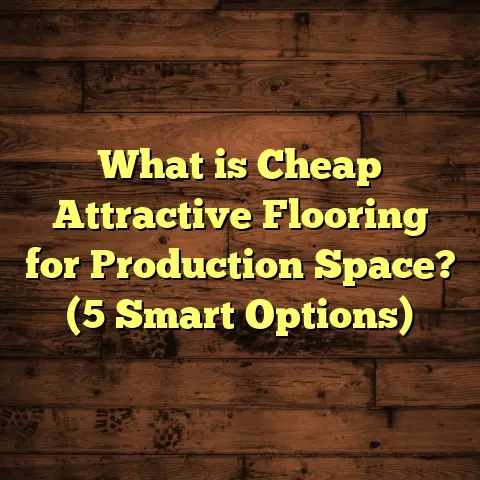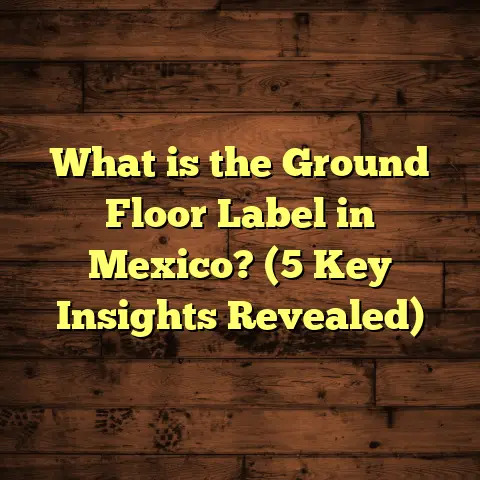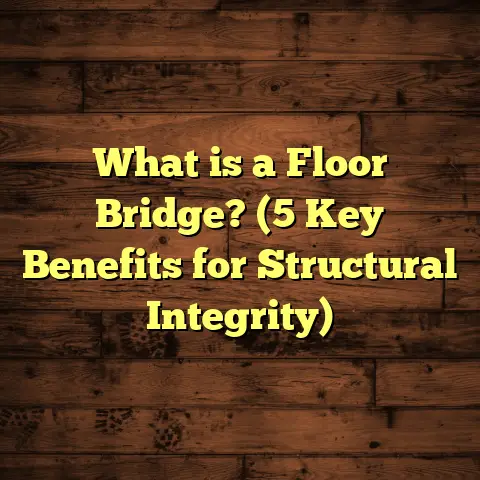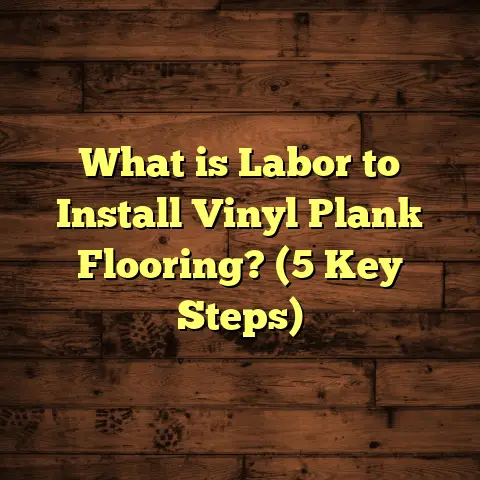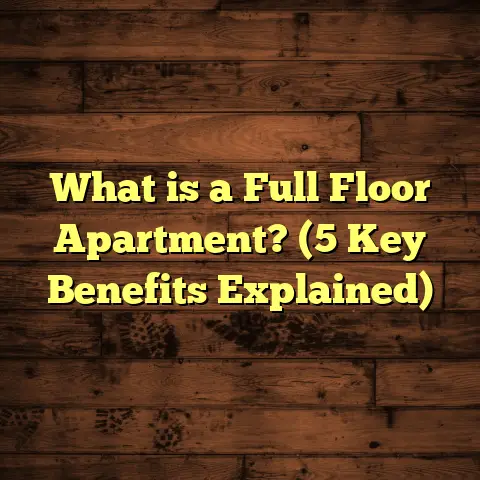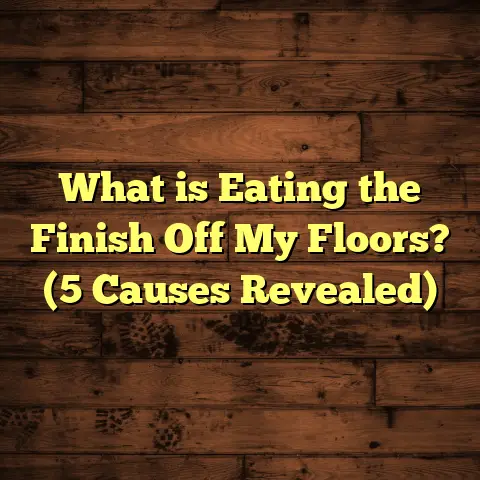What is Glueless Vinyl Flooring? (5 Benefits You Need to Know)
Have you ever thought about changing your home’s floors but dreaded the mess and time commitment that usually comes with it? What if I told you there’s a way to install beautiful, durable floors without glue, nails, or professional contractors? That’s exactly what glueless vinyl flooring offers, and after years of working with it in various homes, I can tell you it’s a game changer.
What is Glueless Vinyl Flooring?
Glueless vinyl flooring is a type of resilient flooring made primarily from vinyl that snaps together using a click-lock system instead of glue or nails. This floating floor system sits on top of your existing subfloor rather than being permanently adhered.
Key Characteristics
- Material: Made from polyvinyl chloride (PVC), sometimes combined with composite cores like WPC (Wood Plastic Composite) or SPC (Stone Plastic Composite).
- Dimensions: Common plank sizes range from about 6 inches to 9 inches wide and 36 to 48 inches long. Thickness typically ranges between 3mm and 8mm.
- Installation: Click-lock or tongue-and-groove edges snap together to lock the planks in place.
- Surface: Often comes with a wear layer measured in mils (thousandths of an inch) — standard thickness is between 12 mil and 30 mil for residential use.
- Backing: Some varieties have attached underlayments, like cork or foam, for sound absorption.
How It Differs from Other Vinyl Flooring Types
- Glue-Down Vinyl: Requires adhesive applied to the subfloor, meaning longer installation times and potential mess.
- Loose Lay Vinyl: Simply laid down without adhesive but without locking mechanisms, so it can shift.
- Glueless Vinyl: Combines ease of loose lay with stability by snapping pieces together.
Why Does This Matter?
The floating nature allows for faster installation, easier repairs, and flexibility in placement. Plus, in places where moisture is a concern—like basements or bathrooms—the lack of glue reduces risk of adhesive failure.
My Journey With Glueless Vinyl Flooring
When I first started out as a flooring contractor over a decade ago, hardwood or glued vinyl were my usual recommendations. I was skeptical about floating floors because I thought they might feel cheap or less durable.
But then I had a client who needed a quick kitchen remodel before a big family event. We chose SPC glueless vinyl flooring for its waterproof core and fast installation. The entire 350-square-foot kitchen went down in about 5 hours. No drying times. No waiting around.
That project opened my eyes. The floor looked good, felt solid underfoot, and has held up beautifully for over five years now.
Since then, I’ve installed glueless vinyl in living rooms, bathrooms, basements, and even light commercial spaces. It consistently delivers convenience without sacrificing quality.
5 Benefits You Need to Know About Glueless Vinyl Flooring
1. Easy and Fast Installation Saves Time and Money
One of the biggest draws is how quickly you can install glueless vinyl flooring. Unlike glue-down systems that need subfloor prep and drying times (sometimes up to 24-48 hours), clicking planks together is straightforward.
I timed myself recently installing 400 square feet in a client’s basement. It took me just over six hours from unpacking to clean-up. Compare that with hardwood or tile installations that often require days or weeks between steps.
Installation Basics
- Tools Needed: Utility knife or vinyl cutter, tapping block, pull bar, spacers.
- Subfloor Prep: Must be dry, flat (within 3/16 inch over 10 feet), clean.
- Acclimation: Planks should rest in the room for 48 hours to adjust to temperature and humidity.
- Layout: Start along the longest wall, leaving about a 1/4-inch expansion gap around the perimeter.
Because no glue is involved, there’s no sticky mess to worry about, which also means less ventilation or waiting time before moving furniture back in.
Personal Tip:
I always recommend measuring your space twice and ordering 7-10% extra material for waste during cuts—especially if your room has lots of corners or odd angles.
Time Comparison Table for Various Flooring Types
| Flooring Type | Avg. Installation Time for 300 sq.ft | Notes |
|---|---|---|
| Glueless Vinyl | 4-6 hours | No drying time |
| Glue-Down Vinyl | 2-3 days | Includes adhesive drying time |
| Hardwood | 3-5 days | Requires finishing & curing |
| Tile | 4-7 days | Grout drying adds time |
2. Budget-Friendly Option Without Compromise
Cost is often what decides if a project moves forward. When I first tried glueless vinyl flooring on my own home five years ago, I was blown away by how affordable it was compared to hardwood or tile.
Material Cost Breakdown
- Basic vinyl planks start at around $2 per square foot.
- Mid-range options with enhanced wear layers cost $3-$5 per square foot.
- Premium styles with thick wear layers or attached underlayment can go up to $7 per square foot.
Compare that to hardwood floors that typically run $8-$12 per square foot for materials alone.
Labor Costs
If you hire professionals, expect $1.50-$3 per square foot depending on region and complexity. But because glueless vinyl is so easy to install, many homeowners choose DIY.
Waste Factor
FloorTally is a tool I use to estimate costs accurately. It accounts for waste (usually 5-10%) so I don’t order too little or too much material. It also factors local labor rates and material prices for realistic budgeting.
This tool helped me plan a recent project in Chicago where material costs rose sharply due to supply issues—knowing my exact budget saved me headaches.
3. Waterproof and Durable for Various Spaces
Durability is often what people worry about with vinyl flooring. Can it hold up against kids, pets, and spills?
The answer is yes—especially with SPC and WPC cores designed for waterproofing.
What Makes It Waterproof?
Unlike older vinyl sheets glued down, glueless vinyl planks have waterproof cores made from stone plastic composite (SPC) or wood plastic composite (WPC). These materials don’t absorb water like plywood or fiberboard cores do.
In fact, SPC cores are up to 100% waterproof and resistant to mold and mildew.
Real-Life Case Study
I installed SPC glueless vinyl in a Minnesota basement laundry room prone to occasional flooding due to sump pump failure. After two years of minor leaks and high humidity, the floor looks as good as new with no signs of warping or mold.
Many homeowners report similar experiences in bathrooms and kitchens where moisture exposure is frequent.
Wear Layer Matters Too
The wear layer protects against scratches and stains. For residential areas with pets or kids, I recommend at least 20 mil thickness for better durability.
4. Comfort Underfoot and Sound Insulation
Have you noticed how some floors feel “hard” and echo with every step? Glueless vinyl floors offer noticeable comfort because they float above the subfloor instead of being rigidly nailed down.
Some products include attached cork or foam underlayments that soften footsteps and reduce noise transfer between floors.
My Experience With Sound Reduction
In a two-story condo project I worked on last year, installing vinyl planks with cork backing reduced upstairs noise complaints by 40% compared to previous laminate flooring.
This makes them ideal for apartments or multi-family homes where noise control is important.
5. Design Flexibility That Won’t Break the Bank
One thing I love about glueless vinyl is how far design technology has come. You can get floors mimicking high-end materials like natural wood grains, marble tiles, concrete textures—all at affordable prices.
Variety Available
- Wood Look: Oak, hickory, walnut textures that closely resemble real hardwood.
- Stone & Tile Look: Marble, travertine, slate patterns.
- Modern Styles: Concrete gray tones or abstract designs.
I recently helped a client pick a vinyl floor that looked like hand-scraped maple wood but cost less than half what real hardwood would have been.
Common Questions About Glueless Vinyl Flooring (Answered!)
Can I Install Glueless Vinyl Over Existing Flooring?
Yes! One advantage is you often don’t need to remove old flooring if it’s flat and secure. You can install over tile, hardwood, or laminate as long as the surface is level within 3/16 inch over 10 feet.
How Long Does Glueless Vinyl Flooring Last?
With proper care and moderate foot traffic, expect about 15-20 years of life for residential use. Some higher-end products offer warranties up to 25 years.
Is It Suitable for Commercial Use?
Yes, but choose products rated for commercial wear layers and durability. They tend to have thicker wear layers (30 mil+) and enhanced cores for heavy traffic areas.
Step-by-Step Guide to Installing Glueless Vinyl Flooring
Here’s how I walk clients through the process:
Step 1: Prepare Your Subfloor
Clean thoroughly. Remove debris and vacuum dust. Check flatness with a level; fill low spots with leveling compound if needed.
Step 2: Acclimate Your Planks
Leave unopened boxes in the installation room for 48 hours minimum for temperature adjustment.
Step 3: Plan Your Layout
Decide on direction (usually longest wall), calculate plank arrangement to avoid small slivers at edges.
Step 4: Install Underlayment (If Not Pre-Attached)
Roll out foam or cork underlayment if your planks don’t come with one attached.
Step 5: Snap First Row Together
Use spacers against walls for expansion gap. Connect planks by aligning tongues and grooves then tapping gently with a block.
Step 6: Continue Row by Row
Stagger seams by at least 6 inches between rows for stability and appearance.
Step 7: Trim Final Pieces
Use utility knife or saw designed for vinyl as planks cut easily but cleanly.
Step 8: Install Molding & Transitions
Cover expansion gaps with quarter-round molding or transition strips around doorways.
Maintaining Your Glueless Vinyl Floor So It Lasts
Maintenance is simple compared to other flooring types:
- Regular Cleaning: Sweep or vacuum regularly to remove dirt.
- Mopping: Use damp mop with mild cleaner specifically formulated for vinyl.
- Avoid Harsh Chemicals: Stay away from abrasive cleaners or wax-based products.
- Protect High-Traffic Areas: Place rugs at entryways; use furniture pads under heavy items.
In my own home, I clean my glueless vinyl floor twice weekly with a microfiber mop and pH-neutral cleaner—no issues after five years of daily wear from kids and pets.
Real Project Breakdown: Kitchen Remodel With Glueless Vinyl Flooring
Here’s a detailed case study from one of my recent projects:
Location: Columbus, Ohio
Room Size: 320 square feet
Material Chosen: SPC vinyl planks with attached cork underlayment
Material Cost: $4.50 per sq.ft (including waste)
Labor Cost: $2 per sq.ft
Total Project Time: 6 hours
Challenges: Irregular wall angles requiring precise cuts
Outcome: Client satisfied with warm look + waterproof performance
Using FloorTally helped me budget accurately before ordering materials and scheduling installers. The client saved roughly $1,200 compared to hardwood alternatives while gaining easier maintenance benefits.
Comparing Glueless Vinyl Flooring With Other Popular Options
| Feature | Glueless Vinyl | Hardwood Floor | Laminate Flooring | Tile Flooring |
|---|---|---|---|---|
| Installation Ease | Very Easy | Moderate to Difficult | Easy | Difficult |
| Water Resistance | Excellent | Poor | Moderate | Excellent |
| Comfort | Good | Moderate | Moderate | Hard |
| Durability | Good – Excellent | Excellent | Moderate | Excellent |
| Cost (Materials Only) | $2 – $7 / sq.ft | $8 – $15 / sq.ft | $1.50 – $3 / sq.ft | $5 – $15 / sq.ft |
| Maintenance | Easy | Moderate | Easy | Moderate |
| Replacement / Repair | Easy | Difficult | Moderate | Difficult |
Wrapping Up My Thoughts on Glueless Vinyl Flooring
After working closely with this material over years of projects—both DIY installs and professional jobs—I have grown confident recommending glueless vinyl flooring for many homeowners seeking affordable yet attractive options.
It combines speed of installation without adhesives; durability suitable for moisture-prone areas; comfort underfoot; sound control benefits; plus wide design choices that mimic pricier materials perfectly well.
If you’re thinking about upgrading your floors soon but dread the hassle or cost—not to mention possible damage from water—this might just be the perfect solution for you.
Got questions about installing glueless vinyl yourself? Or curious about what product brands I trust? Just ask—I’m happy to share what I’ve learned firsthand!
